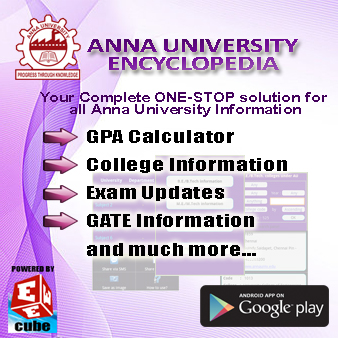SUBJECT RESOURCES:
CLICK HERE to access 'Question Banks'
CLICK HERE to access 'Previous Year Question Papers'
CLICK HERE to access 'Important VHDL Programs'
CLICK HERE to access 'Notes'
CLICK HERE to search more about this subject
SYLLABUS:
CLICK HERE to access 'Question Banks'
CLICK HERE to access 'Previous Year Question Papers'
CLICK HERE to access 'Important VHDL Programs'
CLICK HERE to access 'Notes'
CLICK HERE to search more about this subject
SYLLABUS:
|
EE2255
|
DIGITAL LOGIC CIRCUITS
|
L T
|
P C
|
|
|
|
3 1
|
0 4
|
AIM
To introduce the fundamentals of Digital
Circuits, combinational and sequential
circuit.
OBJECTIVES
i. To study various number systems and to simplify the mathematical expressions
using Boolean functions – simple problems.
ii. To study implementation of combinational
circuits
iii. To study the design of various synchronous and asynchronous circuits. iv. To expose the students to various memory devices.
v. To introduce
digital
simulation techniques for development of
application oriented
logic circuit.
UNIT I BOOLEAN
ALGEBRA AND COMBINATIONAL CIRCUITS 9
Boolean algebra: De-Morgan’s theorem, switching functions and
simplification using K-maps & Quine McCluskey method, Design of adder, subtractor, comparators, code converters,
encoders,
decoders, multiplexers and demultiplexers.
UNIT II SYNCHRONOUS SEQUENTIAL CIRCUITS 9
Flip flops - SR, D, JK and T. Analysis of synchronous sequential circuits; design of synchronous
sequential
circuits – Counters, state diagram; state reduction; state assignment.
UNIT III ASYNCHRONOUS SEQUENCTIAL CIRCUIT 9
Analysis of asynchronous sequential machines, state assignment, asynchronous design problem.
UNIT IV PROGRAMMABLE LOGIC DEVICES, MEMORY AND LOGIC FAMILIES 9
Memories: ROM, PROM, EPROM, PLA, PLD, FPGA, digital logic families: TTL, ECL, CMOS.
UNIT V VHDL 9
RTL Design – combinational logic – Types – Operators – Packages – Sequential
circuit – Sub
programs – Test benches. (Examples: adders, counters, flipflops, FSM, Multiplexers / Demultiplexers).
TEXT BOOKS
L = 45 T = 15
TOTAL: 60 PERIODS
1. Raj Kamal, ‘
Digital
systems-Principles and Design’, Pearson education 2nd edition, 2007
2. M. Morris Mano, ‘Digital Design’, Pearson Education, 2006.
3. John M.Yarbrough, ‘Digital Logic, Application & Design’, Thomson, 2002.
REFERENCES
1.
Charles H.Roth, ‘Fundamentals Logic Design’, Jaico Publishing, IV edition, 2002.
2. Floyd and Jain, ‘Digital
Fundamentals’, 8th edition, Pearson Education, 2003.
3. John F.Wakerly, ‘Digital
Design Principles and Practice’, 3rd edition, Pearson
Education, 2002.
4. Tocci, “Digital Systems : Principles and applications, 8th Edition” Pearson Education|
|










No comments:
Post a Comment
Note: Only a member of this blog may post a comment.